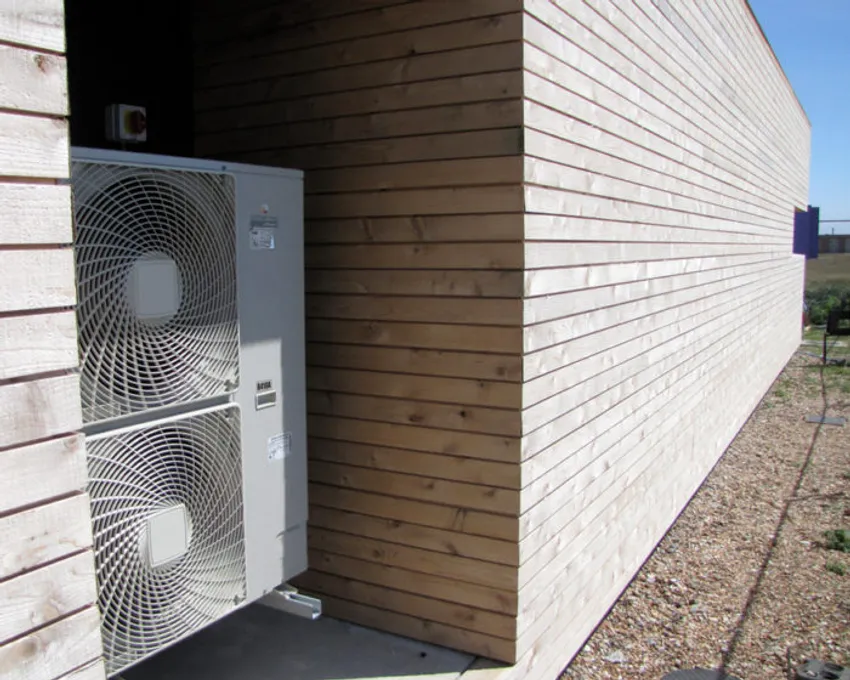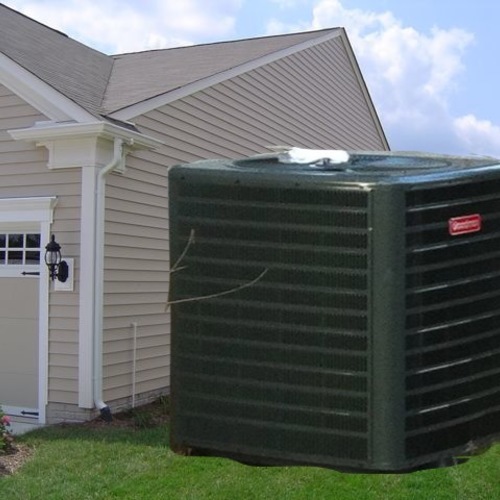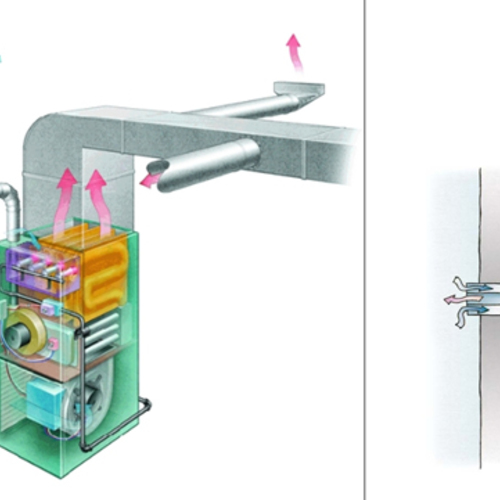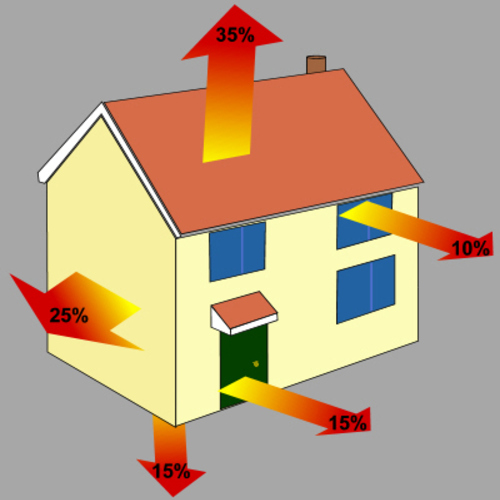
Image Credit: Martin Holladay
To design a residential heating or cooling system, the first step is to perform a load calculation. (A load calculation determines the size of a building’s heating load on one of the coldest nights of the year and the size of a building’s cooling load on one of the hottest afternoons of the year.) It’s important to know the size of these loads to determine the size of the required heating and cooling equipment.
The best way to determine residential heating and cooling loads is with Manual J, a load calculation method developed by the Air Conditioning Contractors of America (ACCA). Manual J calculations are made with a Manual J software program — for example, Adtek AccuLoads, Cool Calc, Elite RHVAC, EnergyGauge, or Wrightsoft RightSuite Universal.
Manual J software doesn’t just provide the heating and cooling load for the entire house; it provides the heating and cooling load of each room in the house. Room-by-room calculations are required, because without them, it’s impossible to design a home’s heating and cooling distribution system (ducts in the case of cooling, and either hydronic tubing or ducts in the case of heating).
Accurate load calculations aren’t just a good idea; they are required by most building codes. In the 2012 IRC, the requirement can be found in Section M1401.3: “Heating and cooling equipment and appliances shall be sized in accordance with ACCA Manual S based on building loads calculated in accordance with ACCA Manual J or other approved heating and cooling calculation methodologies.”
Even though contractors are supposed to show a local code official proof that a load calculation was performed, enforcement of this requirement is spotty. When Allison Bailes was in Aspen, Colorado, a local official mentioned a conversation he had had with other Colorado code officials…
Weekly Newsletter
Get building science and energy efficiency advice, plus special offers, in your inbox.

This article is only available to GBA Prime Members
Sign up for a free trial and get instant access to this article as well as GBA’s complete library of premium articles and construction details.
Start Free TrialAlready a member? Log in















12 Comments
Great start, but its not that simple!
The code, building officials and the building industry have created a world where “all you have to do is perform a Manual J and everything will be alright”. Those of us who live in the real world know that we must perform Manuals J, D, S and T. A Manual J without ALL the other calculations mean NOTHING! Manual J is just the start… and yes, not only most building officials don’t know what to look for in a MJ8, but neither the big majority of the design and building community.
Also let’s be fair, I work with an HVAC contractor who does things right for my clients because he trusts my designs and the builders I work with. He knows that we require and perform 1ACH50, HERS40s in our houses, with systems inside the conditioned space and all metal ducts. He tells me he can’t do the same work with most of his builder clients because they don’t have the same performance standards.
To me it all starts with commitments from the homeowner, the builder and his subs, and the design community. I have chosen not to design houses that doesn’t meet my minimum efficiency standards. I have chosen not to work with homeowners and builders not committed to build same houses. I’ve chosen not to work with any subcontractor (HERS rater, Framer, Insulator, HVAC, etc.) that is not committed to do the work it needs to be done right. It’s just that simple… no fuss, no mess, no arguing and no headaches.
The bottom line, it’s a very complex problem, but if tackled correctly up front, the rest is easy.
online calculator
I am currently dealing with this. I am giving http://www.hvacloadcalculator.com/ a try. It is $39 and hopefully will be helpful. All the HVAC contractors are giving me calculations that are about 3 times what we need.
Response to Michael Brackett
Michael,
From the information provided on the sample print-out, the inputs look simplified. It doesn't look like you can input the window SHGC or glazing U-factor.
It also appears that air leakage rate inputs are vague, with terms like "tightness is average."
-- Martin Holladay
Response to Martin
I think there is a place to input the window manufacturer's U-factor and SHGC, but I'm not sure that you can individually for different windows in the house. I haven't had much time to work on it lately but I will try to learn more about it. Also, it does have a place to input your blower door test results.
Response to Michael Brackett
Michael,
I'm glad to hear that my hunches were wrong.
-- Martin Holladay
make the effort to share the specs
As a homeowner or builder, if you do find a willing HVAC contractor, take the time to actually provide him or her with detailed envelope specs, and make sure that information is accurate (and like, actually figured out ahead of time) and not going to change wildly from design to reality! It seems obvious, but I definitely have seen this *not* happen. In a perfect world the HVAC contractor would ask about and pay attention the envelope design and not just make assumptions, but so should the builder or homeowner go ahead and make sure the envelope info is available and clear and final. For builders over time this can build trust and understanding between you and an HVAC contractor who is willing to do it right, with better buildings as a result.
I suspect a HERS rater or mechanical engineer is probably more likely to prompt a homeowner or builder to provide missing envelope specs or help those who haven't figured out some key aspect of the envelope that affects load calcs to get that figured out, rather than just make an assumption, as is probably more likely to suggest a wise course for said missing envelope spec, so for that reason alone one of those professionals may be worth the money. I would definitely agree to ask the HVAC contractor if they're ok with using a third party's calculations...I have run into those who aren't. (Or maybe it was just my approach that turned him off. Turns out "I know a lot about this trust me do what I say" isn't the most diplomatic way to go...who knew?) Good relationships require effort to build. The one with the HVAC contractor is a really important one.
Michael Brackett,
How did you find using the http://www.hvacloadcalculator.com/ ? Any comments or a mini-review? Looking at the website, I noticed it only seemed to allow up to R-55 which, for us in Ontario, doesn't meet code (OBC) when spec'ing the attic insulation.
http://www.mah.gov.on.ca/AssetFactory.aspx?did=15947
p.34 shows how attics in Ontario now require nominal R-60 insulation.
Let alone address those who super-insulate around R-80 to R-100.
Other than that, the software looks like it's "good enough" and I'd appreciate your comments on it. Thanks.
Side note: is there a way to PM members after the website upgrade?
Jaccen,
Q. "Is there a way to PM members after the website upgrade?"
A. Unfortunately, no. In some cases, I can contact a GBA reader by email and let them know that another GBA reader is interested in contacting them. In this case, I have no access to Michael Brackett's email address (although I may be able to contact Michael -- I'm investigating a work-around).
Thanks Martin. I appreciate the effort. Cheers.
Dear Martin: A belated Thank You for this excellent article. I have yet to find an HVAC contractor that will perform a Mahual J analysis vs the Rule of Thumb "Based on my years in this business, your house needs a X ton air conditioner." So I bought certified Manual J software and did the analysis myself. There were lots of details to collect, e.g. the size, type and U-factor of each window. The results confirmed my guesstimate: The money and effort we spent upgrading insulation and windows made a significant difference. We bought a significantly smaller condenser (2.5 ton) compared to the 4 ton that every contractor recommended. I hired an HVAC contractor (based on Angies List) to install it plus the air handler. (And found basic errors during the install that they fixed.) I also installed al of the ducts myself, because HVAC contractors typically use quick-and-cheap flex duct everywhere, wrapped in knots and poorly sealed. Plus they often use Reflectix to 'insulate' the plenum.
The result: our 'small' condenser works just fine and consumes significantly less energy. Plus we earned a financial return: we recently sold our home and had it Pearl certified. With all of the upgrades, it earned Pearl Platinum. (The Pearl inspector was very knowledgeable and sounded like you.) This added significantly to our home value and it sold in two days, significantly above asking, despite Covid-19. So doing a good job with energy efficiency can pay, while you're living in it and when you sell it.
Mark
Mark,
So glad to hear that someone has the same mentality as a consumer and it paid off even in these odd CoVID-19 times we are living through. I'm also in the market to have my HVAC system replaced, even though the previous owners (bought the place last September) had the system replaced only a year ago. It was clear to me they likely hired the lowest bidder who sold them an oversized system based on the complaint that they were too hot at times. The house has its opportunities for sure as it was built in 1983 and hasn't been through any kind of major remodel from an energy efficiency standpoint. My gut-feel assessment is that the 5-ton system was oversold by at least 1-1.5 tons, even with the house as-is with no air-sealing or insulation improvements.
I second the notion that finding HVAC contractors who'll actually do the work of good load calculation and system design has been a challenge. I earned a degree in mechanical engineering from a local technical institute many years ago but have spent my career in the manufacturing segments of industry. I'm willing to dust off my old heat transfer classwork and do the Manual J calculations myself like you. Can you disclose what software you wound up using and if you'd recommend it to others like myself? I've used coolcalc.com and found it reasonably sophisticated in terms of number of details it asked for. It took me the better part of an hour to get through that process but it came up with a cooling load that was much lower than I would have ever expected (under 3 tons total).
As alluded to above, I'm also planning to invest in making the house more airtight and higher levels of insulation as time goes by. So I'd love to have a software package that allows me to play with those various scenarios to see their ultimate impact on overall cooling and heating load. I'd rather design and purchase this system that will hopefully last me 12-15 years with the end goal in mind, even if that means in the initial years of the system's operation it struggles on more than a few hotter days here in the Atlanta sweltering summers. Then as I make those improvements, the house "catches up" to the smaller sized systems.
Matt H.
Yeah, I paid $800 for a Manual J for a 4,400 sqft house. Dude ignored me about cantilevered second floor exposing floor to exterior and high winds. The report came back with room values ranging from 120% to 60% of actual. (How I know that is a long story.) So "Manual J" is pretty meaningless if not done very carefully.
One comment: I compared to Watts RadiantWorks calculations, and those were very accurate. I am unusual in that I only need heating loads in my location, no need to deal with the complexities of cooling (nor dehumidification).
Log in or become a member to post a comment.
Sign up Log in